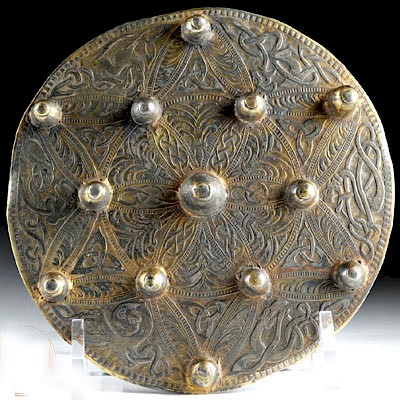19th C. Russian Icons God Father, Mary Magdalene, Jesus
Lot 130
About Seller
Artemis Gallery
686 S Taylor Ave, Ste 106
Louisville, CO 80027
United States
Selling antiquities, ancient and ethnographic art online since 1993, Artemis Gallery specializes in Classical Antiquities (Egyptian, Greek, Roman, Near Eastern), Asian, Pre-Columbian, African / Tribal / Oceanographic art. Our extensive inventory includes pottery, stone, metal, wood, glass and textil...Read more
Estimate:
$4,000 - $6,000
Absentee vs Live bid
Two ways to bid:
- Leave a max absentee bid and the platform will bid on your behalf up to your maximum bid during the live auction.
- Bid live during the auction and your bids will be submitted real-time to the auctioneer.
Bid Increments
| Price | Bid Increment |
|---|---|
| $0 | $25 |
| $300 | $50 |
| $1,000 | $100 |
| $2,000 | $250 |
| $5,000 | $500 |
| $10,000 | $1,000 |
| $20,000 | $2,500 |
| $50,000 | $5,000 |
| $100,000 | $10,000 |
| $200,000 | $20,000 |
About Auction
By Artemis Gallery
Jul 19, 2018
Set Reminder
2018-07-19 10:00:00
2018-07-19 10:00:00
America/New_York
Bidsquare
Bidsquare : Fine Antiquities/Ethnographic Art
https://www.bidsquare.com/auctions/artemis-gallery/fine-antiquities-ethnographic-art-3329
Featuring classical antiquities, ancient and ethnographic art from cultures encompassing the globe, plus fine art. Artemis Gallery info@artemisgallery.com
Featuring classical antiquities, ancient and ethnographic art from cultures encompassing the globe, plus fine art. Artemis Gallery info@artemisgallery.com
- Lot Description
Russia, ca. 19th century CE. Impressive not only for their finely painted images but also for their ornately carved and gilded frames, two diamond-oriented icons in egg tempera and gold leaf on wood. One depicts God the Father donning a triangular halo, symbolic of the Holy Trinity of which he is the fountainhead. The white bearded holy figure is presented as creator of heaven and earth - symbolized by the orb topped with a cross floating upon billowing white clouds - as well as the creator of all things via the Son in the Holy Spirit - symbolized by the white dove. The second icon depicts Mary Magdalene in an adaptation of St. John's gospel of the Myrrh-bearing women on the morning of the Resurrection. The inscription on the left states that Jesus appears to St. Mary Magdalene. In both icons the figures are delineated with fine modeling and a sense of depth that contrasts with the decorative strapwork of stylized geometric motifs lavishly delineated in gold leaf surrounding them. Size: 21" W x 23" H (53.3 cm x 58.4 cm)
Together these icons depict the New Testament Trinity (the Father, Son, and Holy Spirit). Scholar Jeanne Mari Warzeski states about the God the Father Icon, "Even though the Council of Moscow decreed in 1667 that 'the image of Lord Sabaoth shall no longer be depicted or made into an icon, because no one has seen Lord Sabaoth, that is, the Father, in the flesh', nonetheless it did not matter to icon painters and worshippers. Depictions of God the father as an old man have been going on for some 600 years and became quite prevalent during the 18th-19th centuries in all Orthodox countries. Here God is shown with the typical long beard and is also given a triangular halo, a symbol of the Trinity borrowed from western European religious art. The Holy Spirit is seen as a dove, which is how he is described at the baptism of Jesus in the New Testament." Warzeski also states that the inscription translates to “Lord Sabaoth”, that is, “God the Father”.
When asked about the second icon, Warzeski stated, "The other image depicts an adaptation of St. John’s gospel of the Myrrh-bearing women on the morning of the resurrection, showing Mary Magdalene alone. The inscription on the left states that Jesus appears to St. Mary Magdalene. According to the Biblical account, she had been weeping and looked inside the tomb where she found two men in white. She turned around and saw Jesus standing there but thought he was the gardener. She asked where they had taken Jesus’ body. On the right the inscription references John 20 verse 16 (i.e., Jesus said to her, “Mary.” She turned toward him and cried out in Aramaic, “Rabboni!”)"
Icons (icon means "image" in Greek) are sacred objects within the Eastern Orthodox Christian tradition. Found in homes as well as churches, these painted images depict holy persons and saints as well as illustrate scenes from the Scriptures. Some icons are encased in precious metal covers (oklads) adorned with pearls and semi-precious stones or glass-fronted wooden cases (kiots). This example, however, is lavishly decorated with liberal gold leaf strapwork and elaborately carved gilded frames. Icons are not worshiped, but are instead venerated for their ability to focus the power of an individual's prayer to God. As such they are truly "windows into heaven."
Provenance: ex-Francis and Lilly Robicsek collection, Charlotte, North Carolina USA
All items legal to buy/sell under U.S. Statute covering cultural patrimony Code 2600, CHAPTER 14, and are guaranteed to be as described or your money back.
A Certificate of Authenticity will accompany all winning bids.
We ship worldwide and handle all shipping in-house for your convenience.
#119583Painted and gilded surfaces show nice craquelure. Age cracks and losses as shown. The lower pointed termini have unfinished peripheries.Condition
- Shipping Info
-
All shipping is handled in-house for your convenience. Your invoice from Artemis Gallery will include shipping calculation instructions. If in doubt, please inquire BEFORE bidding for estimated shipping costs for individual items.
-
- Buyer's Premium



 EUR
EUR CAD
CAD AUD
AUD GBP
GBP MXN
MXN HKD
HKD CNY
CNY MYR
MYR SEK
SEK SGD
SGD CHF
CHF THB
THB




















